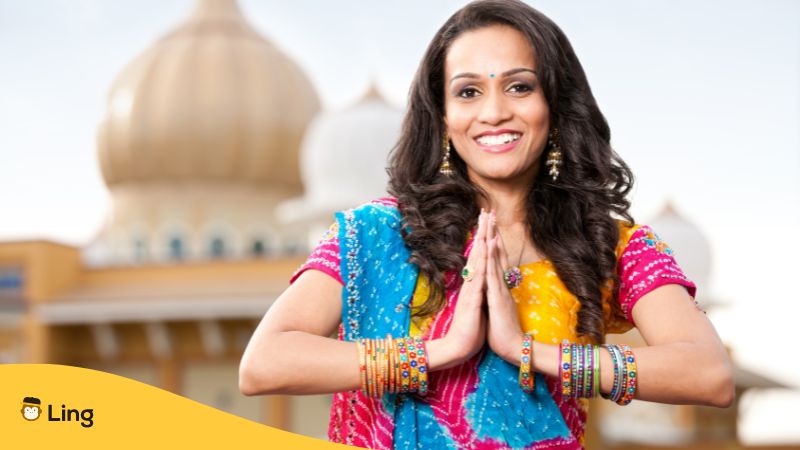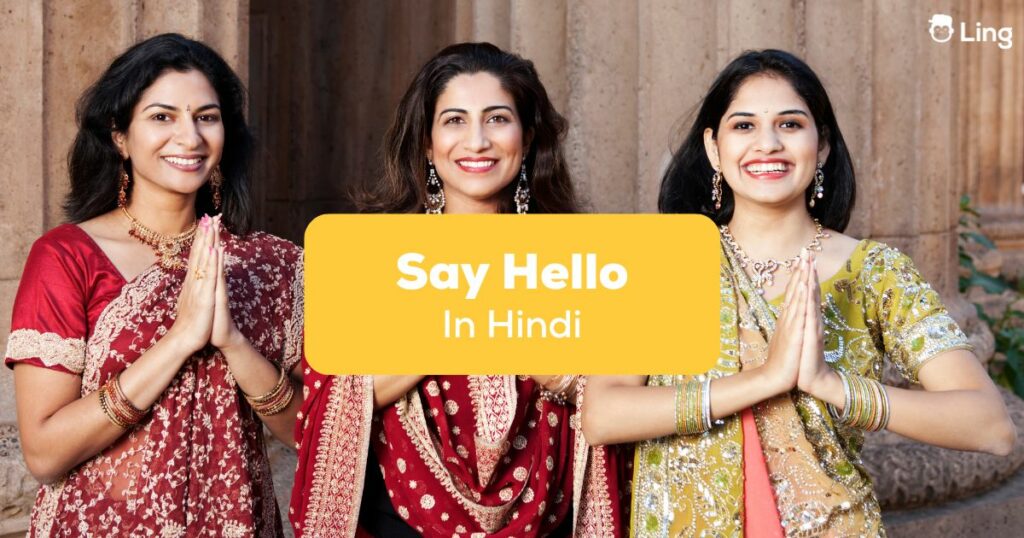There’s a high probability that you’ve heard the word Namaste (नमस्ते) at least once in your lifetime, given the number of Indians migrating all across the world. Well, it’s undoubtedly the most popular way to say Hello in Hindi. It’s probably the most popular Hindi word known globally as well, apart from Yoga (योग) and Chicken Tikka Masala (चिकन टिक्का मसाला)!
But here’s a catch. Not all Indians speak Hindi, as it’s just one of the 22 official languages in the country, and unofficially there are around 780. Still, a majority of Indians use Namaste or its variations to say Hello, even if they aren’t native Hindi speakers. But we’ll read more about this later in the blog post. For now, let’s get started on learning phrases to say hello in Hindi.
Different Ways To Say Hello In Hindi
As an expat or traveler in India, one of the first things you’ll want to learn is how to greet people in the local language. India is a diverse country and Hindi, being the most widely spoken language, is an excellent choice to start with. That’s because Hindi is spoken in many parts of North and Central India (in its various dialects as a native language) and is understood in almost the entire country.
There are states, especially in the South or Northeast of this country, where it’s not as widely popular. Still, you can get by with some basic Hindi greetings in your pocket. Namaste, in fact, is used in many variations in different regions – Namaskar (नमस्कार) and Namaskaram (नमस्कारम) being popular ones.

Formal Greetings In Hindi
1. Namaskar
Namaskar (नमस्कार) is the most formal way of greeting someone in Hindi. This word is derived from the Sanskrit words Namah (bow or venerate) and Kara, which means ‘to do.’ The broad idea behind this greeting is, “I bow down to the Divine in you.” Namah in Sanskrit points to “veneration” or “bowing to the person in veneration.” This comes from the Hindu philosophy of “each soul is a spark of the Supreme Divine Being.”
Thus, when greeting someone, Indians fold their hands together in front of their chest and give a slight bow while saying Namaskar. Its Hindi pronunciation is nuh-muh-skaar.
This is an appropriate greeting to say to elders, highly respected individuals, or in formal settings. It’s a respectful way to acknowledge someone’s presence and can be used as both a greeting and a farewell.
2. Pranaam
Pranaam (प्रणाम) is another formal greeting that native-Hindi speakers use. However, the catch here is that it’s always used by young people to greet their elders.
The word has Sanskrit roots where pra is a prefix that means “before,” and namah is “to bow.” Thus, pranaam means “to bow before.” People greet their parents, grandparents, and elderly relatives with this word while bowing down to touch their feet with their right hand (or both hands) and seek their blessings.
Another important thing to note is that in Indian culture, people also greet their teachers with similar respect and touch their feet while saying pranaam. That’s because, in the Hindu culture, it’s believed that a teacher is not merely a school teacher or a college professor. He or she is a Guru (mentor, guide, life coach) who puts you on the path of knowing the Truth by removing the darkness clouding your intellect.
Now, in modern schools, this practice is officially done away with, as students are not expected to touch their teachers’ feet. But culturally, it’s still quite relevant, and students still say pranaam to their favorite teacher by touching their feet, especially before their exams.

Informal Greetings For Friends
As we mentioned, the most common and universal greeting in Hindi is Namaste (नमस्ते). This word is derived from the Sanskrit phrase Namah Aste, which means “I bow to you.” It’s pronounced nuh-muh-stay with a soft ‘t’ as in French ‘tu.’
While Namaste is the most common greeting, there are several informal greetings you can use to greet friends and family and in casual settings. These include:
| English | Hindi | Transliteration | Pronunciation |
|---|---|---|---|
| Hello | हेलो | Helo | Hey-lo |
| Hi, how are you? | और, कैसे हो? | Aur, kaise ho? | Aur, kay-say ho? |
| Hail Lord Ram | राम राम | Ram Ram | Raa-m Raa-m |
| What’s up? | क्या हाल चाल है? | Kya haal chaal hai? | K-ya haa-l chaa-l hai? |
| All good? | सब बढ़िया? | Sab badhiya? | Sa-b ba-dhi-ya? |
Various Uses Of Namaste
Apart from being a traditional greeting, Namaste is also a common word to say farewell in a formal manner. So, when you’re ready to take leave, fold your hands and say Namaste. The informal way to take leave is by saying Phir milte hain (फिर मिलते हैं), which means, “See you later.”
But do you know the best part? Namaste comes in handy when you want to let that annoying person know that it’s time to go their way when they have overstayed their welcome! Got stuck with a jabber-mouth who doesn’t get the hint that it’s time to end the conversation and go away? Then simply get up from your seat, fold your hands, and say a firm Achha, Namaste. It translates to “ok, goodbye.” Easy-peasy!
Time-Based Greetings
In addition to the general greetings, Hindi has specific phrases for greeting people at different times of the day. Here are some common time-based greetings:
| English | Hindi | Transliteration | Pronunciation |
|---|---|---|---|
| Good morning | सुप्रभात | Suprabhaat | Su-pra-bhaat |
| Good afternoon | शुभ दोपहर/ शुभ मध्याहन | Shubh Dopahar/ Shubh Madhyaahan | Shu-bh do-pa-har/ Shu-bh ma-dhyaa-han |
| Good evening | शुभ संध्या | Shubh Sandhya | Shu-bh san-dhya |
Hindi Phrases To Respond To Greetings
After greeting someone, it’s common to follow up with a short phrase inquiring about their well-being or expressing your own. Here are some common follow-up phrases:
- How are you? – Aap kaise hain? (आप कैसे हैं?)
- Thank you, I am fine – Dhanyawaad, main theek hoon (धन्यवाद, मैं ठीक हूँ)
- Is everything alright? – Sab theek hai? (सब ठीक है?)
You can learn many similar Hindi conversational phrases and vocabulary on the Ling app, too!
Tips To Follow Cultural Etiquette
When greeting someone in Hindi, it’s important to be mindful of cultural etiquette and body language. Here are some tips:
- Joining hands: When saying Namaste, bring your palms together in a prayer-like gesture and slightly bow your head.
- Eye contact: Maintaining eye contact is considered respectful and shows confidence. However, in some regions, prolonged eye contact with elders is considered disrespectful or insolent behavior.
- Personal space: Indians generally prefer to maintain a closer personal space compared to Western cultures. You’ll find it common for people to cross the threshold of personal space in public spaces without batting an eyelid, and no one minds it at all.
- Touching: Avoid touching someone with your feet, especially on the upper body, as it’s considered rude and disrespectful in Indian culture.
Wrapping Up
Learning to say Hello in Hindi is the easiest way to get started with the language. Still, there are some considerations you should keep in mind, like knowing when to use a formal or informal greeting and respecting cultural etiquette. But when you use these basic conversational phrases as ice-breakers, Indians will be delighted to help you with your grammar and pronunciation. So, all the best on your learning journey!



































































